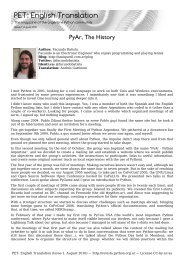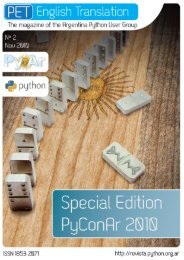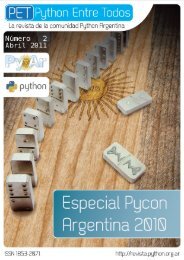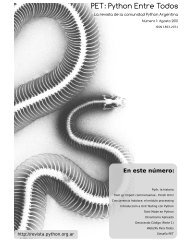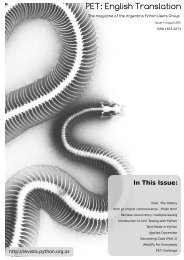color version - PET: Python Entre Todos - Python Argentina
color version - PET: Python Entre Todos - Python Argentina
color version - PET: Python Entre Todos - Python Argentina
You also want an ePaper? Increase the reach of your titles
YUMPU automatically turns print PDFs into web optimized ePapers that Google loves.
Memory debugging and defragmentation<br />
Author: Claudio Freire<br />
How would you say <strong>Python</strong> manages memory Malloc (a C function that reserves<br />
memory for those unfamiliar with C)<br />
Well, no. <strong>Python</strong> has unusual and very specific requirements, if it used malloc for all of<br />
its memory needs, it would be too inefficient. <strong>Python</strong> uses, instead, a series of techniques<br />
and strategies designed to minimize malloc calls, which are very slow to be used in the<br />
core of <strong>Python</strong>’s virtual machine.<br />
• Pools<br />
Introduction<br />
This lecture was planned to be given in 20 minutes. If you can’t read it in 20 minutes,<br />
reread, reread and re-reread until it takes 20 minutes :-p<br />
Well, actually the text here is only slightly based in the real lecture. I’m one known to<br />
improvise in lectures, all I have are the slides as a guide, the general guidelines for the<br />
lecture, and this format doesn’t lend itself to improvisation. Besides, no freaking way I’m<br />
going to remember the exact words I used ;)<br />
Now, really… this is a deep convoluted subject. Reread and re-reread until you get it.<br />
When I started looking for lecture subjects, I decided for memory fragmentation because<br />
not long ago I though it was a myth. Ok, yes, it can happen… but, does that happen to<br />
anybody Is it a problem How naive of me to doubt that could answers could be “yes”.<br />
In PyConAr 2010 (and here in this space now), not only I had the chance to transmit<br />
around 4 months of picking <strong>Python</strong>’s guts apart, trying to find out what was going on<br />
with my applications (where I suffered from memory fragmentation), I also learned that<br />
this issue is much, much more common than I’d expected.<br />
When the lecture started, I asked: Does anybody know what memory fragmentation is.<br />
Exactly zero attendants raised their hand. Exactly the amount I had expected. But, in the<br />
end, many approached me saying that the same thing that was happening to me (and<br />
that I described, and will describe below) was happening to them.<br />
• Integer<br />
• Floating point<br />
• Free lists<br />
• Tuples<br />
• Lists<br />
• Frames (yes, the frames are objects and need to be managed too)<br />
• Arenas<br />
Lets see what each is about, one by one<br />
Pools<br />
Not for swimming.<br />
They’re arrays, object vectors of the same type, that <strong>Python</strong> uses usually to accelerate<br />
the creation and destruction of common objects, like integers and floating point<br />
numbers.<br />
When python needs one of these objects, it doesn’t create one, it creates many (as many<br />
as they fit in a pool block), and keeps a linked list of which objects are free within each<br />
block.<br />
That, according to my post-PyCon estimations, means a 10% of everyone present<br />
(assuming they’re <strong>Python</strong> developers) suffer from that issue, and to a 3% of them it<br />
means serious operative problems. So the issue was far more relevant than I had<br />
expected.<br />
How does <strong>Python</strong> manage memory<br />
Before going into this fragmentation thing, we must study some internal details of how<br />
memory management works in <strong>Python</strong>.



